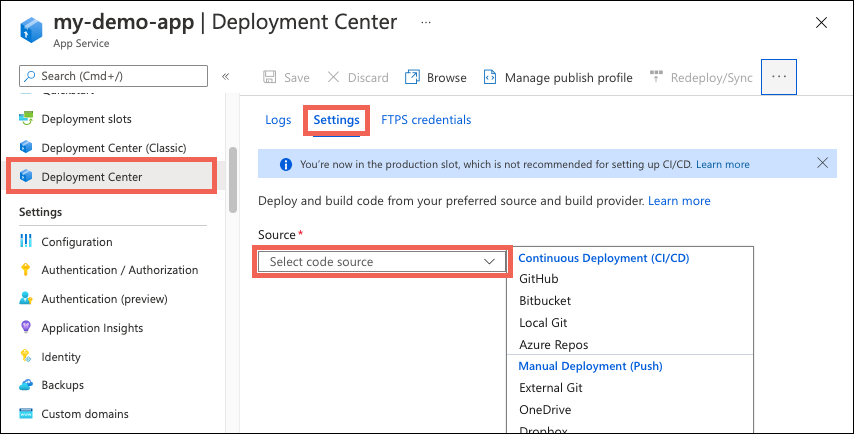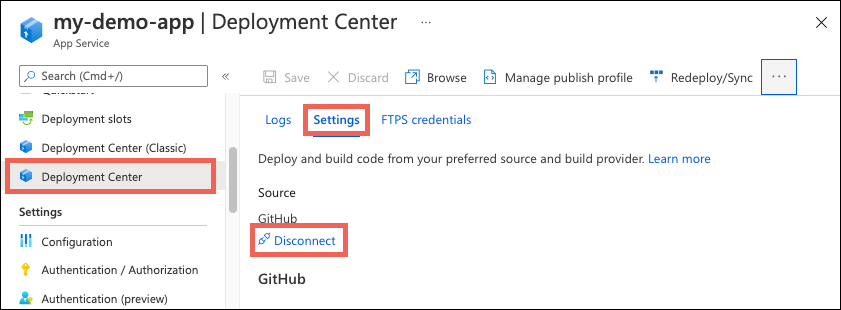Events
Mar 17, 9 PM - Mar 21, 10 AM
Join the meetup series to build scalable AI solutions based on real-world use cases with fellow developers and experts.
Register nowThis browser is no longer supported.
Upgrade to Microsoft Edge to take advantage of the latest features, security updates, and technical support.
Note
Starting June 1, 2024, newly created App Service apps can generate a unique default hostname that uses the naming convention <app-name>-<random-hash>.<region>.azurewebsites.net. Existing app names remain unchanged. For example:
myapp-ds27dh7271aah175.westus-01.azurewebsites.net
For more information, see Unique Default Hostname for App Service Resource.
Azure App Service enables continuous deployment from GitHub, Bitbucket, and Azure Repos repositories by pulling in the latest updates.
To get automated builds from Azure App Service build server, make sure that your repository root has the correct files in your project.
| Runtime | Root directory files |
|---|---|
| ASP.NET (Windows only) | *.sln, *.csproj, or default.aspx |
| ASP.NET Core | *.sln or *.csproj |
| PHP | index.php |
| Ruby (Linux only) | Gemfile |
| Node.js | server.js, app.js, or package.json with a start script |
| Python | *.py, requirements.txt, or runtime.txt |
| HTML | default.htm, default.html, default.asp, index.htm, index.html, or iisstart.htm |
| WebJobs | <job_name>/run.<extension> under App_Data/jobs/continuous for continuous WebJobs, or App_Data/jobs/triggered for triggered WebJobs. For more information, see Kudu WebJobs documentation. |
| Functions | See Continuous deployment for Azure Functions. |
To customize your deployment, include a .deployment file in the repository root. For more information, see Customize deployments and Custom deployment script.
Note
If you use Visual Studio, let Visual Studio create a repository for you. Your project will immediately be ready for deployment via Git.
In the Azure portal, go to the management page for your App Service app.
In the left pane, select Deployment Center. Then select Settings.
In the Source box, select one of the CI/CD options:

Select the tab that corresponds to your build provider to continue.
GitHub Actions is the default build provider. To change the provider, select Change provider > App Service Build Service > OK.
If you're deploying from GitHub for the first time, select Authorize and follow the authorization prompts. If you want to deploy from a different user's repository, select Change Account.
After you authorize your Azure account with GitHub, select the Organization, Repository, and Branch you want.
If you can’t find an organization or repository, you might need to enable more permissions on GitHub. For more information, see Managing access to your organization's repositories.
Under Authentication type, select User-assigned identity for better security. For more information, see frequently asked questions.
Note
If your Azure account has the required permissions for the User-assigned identity option, Azure creates a user-assigned managed identity for you. If you don't, work with your Azure administrator to create an identity with the required role on your app, then select it here in the dropdown.
(Optional) To see the file before saving your changes, select Preview file. App Service selects a workflow template based on the language stack setting of your app and commits it into your selected GitHub repository.
Select Save.
New commits in the selected repository and branch now deploy continuously into your App Service app. You can track the commits and deployments on the Logs tab.
In the Azure portal, go to the management page for your App Service app.
In the left pane, select Deployment Center. Then select Settings > Disconnect:

By default, the GitHub Actions workflow file is preserved in your repository, but it continues to trigger deployment to your app. To delete the file from your repository, select Delete workflow file.
Select OK.
Depending on your deployment source in the Deployment Center, you might see a few options to select for build providers. Build providers help you build a CI/CD solution with Azure App Service by automating build, test, and deployment.
You're not limited to the build provider options found in the Deployment Center, but App Service lets you set them up quickly and offers some integrated deployment logging experience.
The GitHub Actions build provider is available only for GitHub deployment. When configured from the app's Deployment Center, it completes these actions to set up CI/CD:
You can customize the GitHub Actions build provider in these ways:
All the officially supported deployment methods make changes to the files in the /home/site/wwwroot folder of your app. These files are used to run your app. So the deployment can fail because of locked files. The app might also behave unpredictably during deployment because the files aren't all updated at the same time. This behavior is undesirable for a customer-facing app. There are a few ways to avoid these issues:
No. Try using GitHub Actions with the user-assigned identity option.
For more information, see Deployment without basic authentication.
When you select user-assigned identity under the GitHub Actions source, App Service configures all the necessary resources in Azure and in GitHub to enable the recommended OpenID Connect authentication with GitHub Actions.
Specifically, App Service does the following operations:
AZURE_CLIENT_ID, AZURE_TENANT_ID, and AZURE_SUBSCRIPTION_ID from the federated credential in your selected GitHub repository.In a GitHub Actions workflow in your GitHub repository, you can then use the Azure/login action to authenticate with your app by using OpenID Connect. For examples, see Add the workflow file to your GitHub repository.
If your Azure account has the required permissions, App Service creates a user-assigned managed identity and configures it for you. This identity isn't shown in the Identities page of your app. If your Azure account doesn't have the required permissions, you must select an existing identity with the required role.
The message indicates that your Azure account doesn't have the required permissions to create a user-assigned managed identity for the GitHub Actions. The required permissions (scoped to your app) are:
Microsoft.Authorization/roleAssignments/writeMicrosoft.ManagedIdentity/userAssignedIdentities/writeBy default, the User Access Administrator role and Owner role have these permissions already, but the Contributor role doesn't. If you don't have the required permissions, work with your Azure administrator to create a user-assigned managed identity with the Website Contributor role. In the Deployment Center, you can then select the identity in the GitHub > Identity dropdown.
For more information on the alternative steps, see Deploy to App Service using GitHub Actions.
The message indicates that the selected user-assigned managed identity doesn't have the required role to enable OpenID Connect between the GitHub repository and the App Service app. The identity must have one of the following roles on the app: Owner, Contributor, Websites Contributor. The least privileged role that the identity needs is Websites Contributor.
Events
Mar 17, 9 PM - Mar 21, 10 AM
Join the meetup series to build scalable AI solutions based on real-world use cases with fellow developers and experts.
Register nowTraining
Module
Build and deploy applications to Azure by using GitHub Actions - Training
Create two deployment workflows using GitHub Actions and Microsoft Azure. Learn about triggering a CD workflow and storing credentials.
Certification
Microsoft Certified: Identity and Access Administrator Associate - Certifications
Demonstrate the features of Microsoft Entra ID to modernize identity solutions, implement hybrid solutions, and implement identity governance.
Documentation
Deploy from local Git repo - Azure App Service
Learn how to enable local Git deployment to Azure App Service. One of the simplest ways to deploy code from your local machine.
Deploy files to App Service - Azure App Service
Learn to deploy various app packages or discrete libraries, static files, or startup scripts to Azure App Service.
Deployment best practices - Azure App Service
Learn about the key mechanisms of deploying to Azure App Service. Find language-specific recommendations and other caveats.